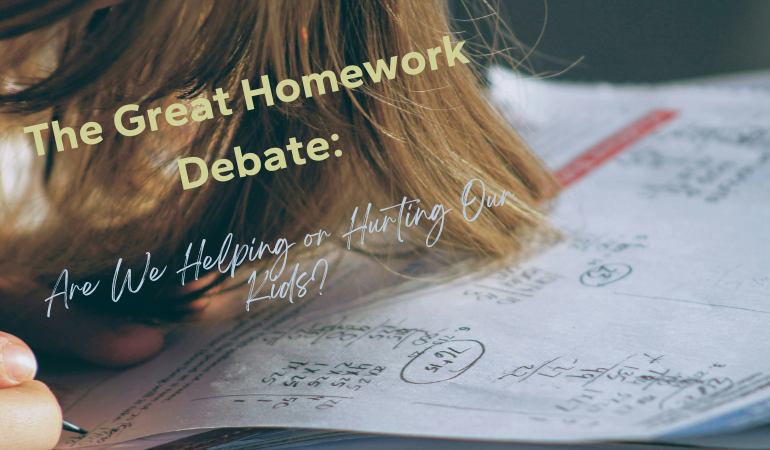You should have seen my checklist. Almost as soon as I got home from school, I would break up my afternoon into 15-minute increments: read two pages of this, do four problems of that.
Homework was the organizing principle of my young life. Early on in my education, I absorbed its rules and regulations. I remember feeling both detached from its value and dedicated to its ritual.
Maybe my methods were a little intense, but I knew my day had to be divided and structured around the work I had to complete after already spending hours at school — or else. I started this routine in middle school and carried it through high school.
But did all that homework make me a better student? Did it prepare me for college and beyond? Or did it just turn school into a relentless cycle of completing tasks, earning grades, and avoiding mistakes?
Now, as an educator and a parent, I’ve rethought my approach to homework. And I know that for many families, the question of homework—too much or too little of it—looms large. Some of this honest concern comes from our own experience, and some comes from the uncertainty of the moment when everything is shifting.
To help, it’s worth reviewing what research says about homework’s benefits and drawbacks and exploring how Montessori students develop the skills they need—without the nightly battle over worksheets.
The Traditional Case for Homework: Does More Work Mean More Learning?
For over a century, homework has been considered a cornerstone of traditional education and an essential part of academic success.
The argument is straightforward: more practice leads to better retention, stronger study habits, and greater preparedness for the future. Research does show some correlation between homework and achievement—particularly in high school (Cooper et al. 1-62).
- Moderate homework can improve test scores. High school students who complete 30–90 minutes of math homework each day tend to score about 40 points higher on standardized tests like the SAT than those who do none (Cooper et al.).
- Homework reinforces learning. Students typically retain only about half of what they hear in class, so reviewing material at home can strengthen memory and understanding (Pope et al.)
- It builds self-discipline. Time management, organization, and problem-solving skills are often cited as benefits of regular homework (Zimmerman & Schunk).
But the research also reveals a more complicated reality.
- The benefits of homework are age-dependent. Studies consistently show that in elementary school, homework has little to no measurable impact on academic achievement (Cooper et al.).
- More is not always better. Beyond 1.5–2 hours of homework per night, academic benefits plateau—and even decline. Too much homework has been linked to burnout, anxiety, and sleep deprivation, especially in high-achieving schools (Pope et al.).
- It can erode motivation. Many students complete homework not to deepen their learning but simply to earn points, avoid punishment, or meet expectations—a shift that can make learning feel transactional rather than meaningful (Kohn).
So while traditional homework can provide some benefits—particularly in upper grades—the key factors are purpose and moderation. Without careful design, homework can quickly become counterproductive.
Why Montessori Classrooms Limit Homework in Early Childhood and Elementary
Up until Junior High, Montessori education takes a different approach. Rather than relying on after-school assignments, Montessori Primary and Elementary schools structure learning to happen during the school day.
Dr. Maria Montessori believed that children learn best when they are actively engaged in self-directed, hands-on work. Traditional homework, often rooted in passive repetition, doesn’t fit that model (Montessori).
Instead:
- Mastery happens in the classroom. Montessori classrooms are designed for deep, uninterrupted work periods where students practice and apply what they’re learning (Lillard 205).
- Learning is active, not passive. Students work with concrete materials that reinforce concepts in tangible ways, making worksheets unnecessary.
- Curiosity drives learning. Instead of assigning rote work, Guides often encourage families to support children’s natural interests—reading aloud, cooking together, or exploring a favorite topic.
As Montessori educator John R. Snyder puts it, “People learn best when they are learning something that personally interests them… and having some sense of control over one’s learning is a prerequisite of personal interest.” This emphasis on autonomy isn’t just philosophical—it’s protective.
Snyder warns that, “The negative emotion that accompanies being coerced to ‘learn’ is likely to remain permanently attached to the subject… and may obstruct all future attempts to learn that subject.”
Rather than enforcing one-size-fits-all assignments, Montessori invites families to participate in a broader definition of learning at home. Snyder writes, “We are looking not for worksheets and assignments but for learning as a way of life, both at home and at school.”
In the Elementary years, we prioritize that space for self-direction. It’s not that we think learning should stop at 3:00 pm—it’s that we believe a child’s natural curiosity and participation in family life offer better pathways for real development.
So What Do Montessori Students Do at Home?
In lieu of traditional homework, Snyder encourages families to create a rich, balanced learning environment that reflects the whole child. Here are just a few examples he suggests:
- Spend time reading aloud from great books or listening to audiobooks.
- Cook together—measuring, following directions, and practicing life skills.
- Take apart an old appliance and try to understand how it works.
- Go on a nature walk and identify plants or track distances walked.
- Make art or music; write a letter to a family member.
- Tidy a room, sort laundry, or organize a shelf—real work that builds independence and care.
These experiences consolidate school learning and spark new questions. And, critically, they help develop a child’s sense of responsibility, purpose, and identity. Explore Snyder’s full list of suggestions here: “Homework John Snyder” by John R. Snyder.
What About Homework in Junior High?
Montessori students do begin receiving traditional homework once they enter Junior High (grades 7–9). By this stage, they have the executive functioning, self-regulation, and intrinsic motivation to engage meaningfully in this kind of independent academic work.
At Marin Montessori, Junior High students have homework most nights of the week, including:
- Reading assignments for literature and history discussions
- Written reflections and drafts of essays or creative work
- Science projects and math problem sets
- Research and preparation for debates or Socratic seminars
Homework is thoughtfully assigned to extend in-class learning, support independent thinking, and prepare students for the demands of high school and beyond. But just as importantly, students are taught how to manage their time, advocate for support, and take ownership of their work.
Will Montessori Kids Be Ready?
A common concern among parents is whether Montessori students will be prepared for high school or college, where nightly homework is the norm. The answer, backed by research and experience, is yes.
- They develop time-management skills. Without nightly assignments, Montessori kids learn to plan their own work during the day, a practice that builds responsibility and self-discipline (Lillard & Else-Quest).
- They are intrinsically motivated. Montessori education nurtures curiosity and agency, so students don’t need external rewards or punishments to stay engaged (Montessori Rocks).
- They thrive academically. Studies show Montessori graduates often outperform their peers in high school and college, despite not having had formal homework early on (Lillard & Else-Quest).
When Montessori students transition to traditional settings, there may be an adjustment period—but they typically rise to the challenge with the mindset and skills they’ve developed through years of independent, meaningful work.
Final Thoughts: Rethinking Homework for a New Generation
Montessori education challenges the assumption that more homework = more learning. Instead, it prioritizes purpose, curiosity, and personal growth. This doesn’t just reduce stress—it fosters lifelong learners. The big takeaway?
Homework isn’t inherently good or bad. It depends on the student’s age and the task’s intent.
Montessori students are well-equipped for the future. They’ve practiced independence, responsibility, and critical thinking long before homework shows up in their backpack.
Families still play a huge role. When home becomes a space of inquiry and contribution—not coercion—children thrive.
As Snyder reminds us: “The home will ultimately have a far greater influence on the child’s future way of life than will the school.” So rather than seeing homework as a battleground, we can reframe it—especially in the early years—as an invitation to explore, to connect, and to live a meaningful life of learning.
Works Cited
Cooper, H., Robinson, J. C., & Patall, E. A. “Does Homework Improve Academic Achievement? A Synthesis of Research, 1987–2003.” Review of Educational Research, vol. 76, no. 1, 2006, pp. 1–62.
Kohn, Alfie. The Homework Myth: Why Our Kids Get Too Much of a Bad Thing. Da Capo Lifelong Books, 2006.
Lillard, Angeline Stoll. Montessori: The Science Behind the Genius. Oxford University Press, 2005.
Lillard, A. S., & Else-Quest, N. “Evaluating Montessori Education.” Science, vol. 313, no. 5795, 2006, pp. 1893–1894.
Montessori, Maria. The Absorbent Mind. Henry Holt & Co., 1995.
Montessori Rocks. “Do Montessori Students Do Homework?” montessorirocks.org.
Pope, Denise, et al. “Overloaded and Underprepared.” Journal of Youth and Adolescence, 2015.
Snyder, John R. “Homework and the Elementary Child.” Austin Montessori School, 2023.
Zimmerman, Barry J., and Schunk, Dale H. Self-Regulated Learning and Academic Achievement. Routledge, 2011.
OpenAI’s ChatGPT-4, consulted April 2025, used for synthesis and editorial support.
.

Terry is the Director of Communications and Strategic Initiatives at Marin Montessori School. A classroom teacher for 30 years, he manages Grounded and Soaring.





